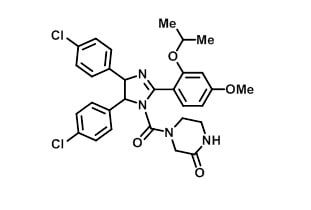MDM2 inhibitor Nutlin-3 Small Molecule (Tool Compound)
Invented by Prof Bernard Golding from University of Newcastle upon Tyne
Invented at
- Datasheet
- References (4)
- Inventor Info
Info
| Antigen/Gene or Protein Targets | MDM2/p53 |
| Synonyms |
(±)-4-[4,5-Bis(4-chlorophenyl)-2-(2-isopropoxy-4-methoxyphenyl)-4,5-dihydro-1H-imidazole-1-carbonyl]piperazin-2-one CAS No. 548472-68-0 |
| Type | Inhibitor |
| Relevance | MDM2 inhibitor Nutlin-3 potently inhibits the MDM2-p53 interaction, leading to the activation of the p53 pathway. Loss of p53 activity, by deletion, mutation, or MDM2 overexpression, is the most common event in the development and progression of cancer, while the restoration of endogenous p53 function results in tumor regression in vivo. In this context, the rescue of the impaired p53 activity and resensitization to apoptosis in cancer cells by disrupting the MDM2−p53 interaction offers an opportunity for anticancer therapeutics. Nutlin-3 is a wild-type p53 activator which acts by binding and inhibiting MDM2. |
| On Target IC50 | IC50 of 90 nM in a cell-free assay |
| Molecular Formula | C30H30Cl2N4O4 |
| Molecular Weight (g/mol) | 581.49 |
| In vivo applications | Oral administration of Nutlin-3 at 200 mg/kg twice daily for 3 weeks significantly inhibits the tumor growth of SJAS-1 xenografts by 90%, comparable with the effect of doxorubicin treatment with 81% inhibition of tumor growth. |
| In vitro applications | Nutlin-3 potently inhibits the MDM2-p53 interaction, leading to the activation of the p53 pathway. Nutlin-3 treatment induces the expression of MDM2 and p21, and displays potent antiproliferative activity with IC50 of ~1.5 μM, only in cells with wild-type p53 such as HCT116, RKO and SJSA-1, but not in the mutant p53 cell lines SW480 and MDA-MB-435. In SJSA-1 cells, Nutlin-3 treatment at 10 μM for 48 hours significantly induces caspase-dependent cell apoptosis by ~45%. Although Nutlin-3 also inhibits the growth and viability of human skin (1043SK) and mouse embryo (NIH/3T3) with IC50 of 2.2 μM and 1.3 μM, respectively, cells remain viable 1 week post-treatment even at 10 μM of Nutlin-3, in contrast with the SJSA-1 cells with viability lost at 3 μM of Nutlin-3 treatment. Nutlin-3 does not induce the phosphorylation of p53 on key serine residues and reveals no difference in their sequence-specific DNA binding and ability to transactivate p53 target genes compared with phosphorylated p53 induced by the genotoxic drugs doxorubicin and etoposide, demonstrating that phosphorylation of p53 on key serines is dispensable for transcriptional activation and apoptosis. Although binding less efficiently to MDMX than to MDM2, Nutlin-3 can block the MDMX–p53 interaction and induce the p53 pathway in retinoblastoma cells (Weri1) with IC50 of 0.7 μM. Nutlin-3 at 30 μM also disrupts endogenous p73-HDM2 interaction and enhances the stability and proapoptotic activities of p73, leading to the dose-dependent cell growth inhibition and apoptosis induction in cells without wild-type p53. |
| Research Area | Cancer, Cell Cycle, Epigenetics & Nuclear Signalling |
References: 4 entries
Bertamino et al. 2013. J Med Chem. 56(13):5407-21. PMID: 23802716.
Synthesis, in vitro, and in cell studies of a new series of [indoline-3,2'-thiazolidine]-based p53 modulators.
Europe PMC ID: 23802716
Vassilev et al. 2004. Science. 303(5659):844-8. PMID: 14704432.
In vivo activation of the p53 pathway by small-molecule antagonists of MDM2.
Europe PMC ID: 14704432
Add a reference
References: 4 entries
Bertamino et al. 2013. J Med Chem. 56(13):5407-21. PMID: 23802716.
Synthesis, in vitro, and in cell studies of a new series of [indoline-3,2'-thiazolidine]-based p53 modulators.
Vassilev et al. 2004. Science. 303(5659):844-8. PMID: 14704432.
In vivo activation of the p53 pathway by small-molecule antagonists of MDM2.
Add a reference





